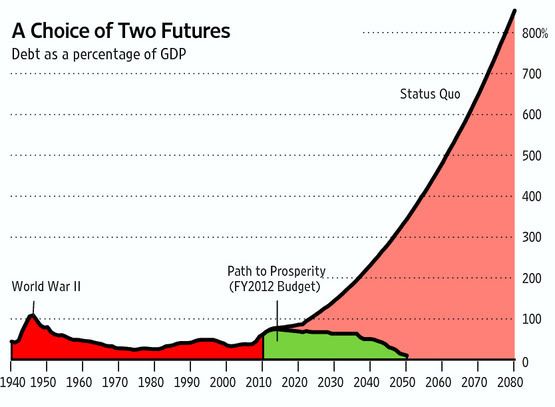Pretty obvious choice, in a sane world:

The status quo is even worse than indicated.
In something I’ve learned in being associated with the Pajamas Media National Economic Rescue Initiative project, the “status quo” scenario naively assumes, as dictated to the Congressional Budget Office by Congress, that interest rates paid by the federal government will remain risk-free (i.e., they will stay very low) even if debt as a percentage of national output gets out of control. As we’ve seen with Greece, Portugal, and other countries, that isn’t the case, and it wouldn’t be the case with us either. So the Status Quo portion of the graph is even steeper than indicated.
This is a graph you will never see in the establishment press. It should be leading the news every night.
Here are portions of Paul Ryan’s Wall Street Journal op-ed:
… this morning the new House Republican majority will introduce a budget that moves the debate from billions in spending cuts to trillions. America is facing a defining moment. The threat posed by our monumental debt will damage our country in profound ways, unless we act.
No one person or party is responsible for the looming crisis. Yet the facts are clear: Since President Obama took office, our problems have gotten worse. Major spending increases have failed to deliver promised jobs. The safety net for the poor is coming apart at the seams. Government health and retirement programs are growing at unsustainable rates. The new health-care law is a fiscal train wreck. And a complex, inefficient tax code is holding back American families and businesses.
The president’s recent budget proposal would accelerate America’s descent into a debt crisis. It doubles debt held by the public by the end of his first term and triples it by 2021. It imposes $1.5 trillion in new taxes, with spending that never falls below 23% of the economy. His budget permanently enlarges the size of government. It offers no reforms to save government health and retirement programs, and no leadership.
Our budget, which we call The Path to Prosperity, is very different. For starters, it cuts $6.2 trillion in spending from the president’s budget over the next 10 years, reduces the debt as a percentage of the economy, and puts the nation on a path to actually pay off our national debt.
… Here are its major components:
• Reducing spending: This budget proposes to bring spending on domestic government agencies to below 2008 levels, and it freezes this category of spending for five years. …
• Welfare reform: This budget will build upon the historic welfare reforms of the late 1990s by converting the federal share of Medicaid spending into a block grant that lets states create a range of options and gives Medicaid patients access to better care. It proposes similar reforms to the food-stamp program, ending the flawed incentive structure that rewards states for adding to the rolls. …
• Health and retirement security: … Starting in 2022, new Medicare beneficiaries will be enrolled in the same kind of health-care program that members of Congress enjoy. Future Medicare recipients will be able to choose a plan that works best for them from a list of guaranteed coverage options. …
• Budget enforcement: This budget recognizes that it is not enough to change how much government spends. We must also change how government spends. It proposes budget-process reforms—including real, enforceable caps on spending—to make sure government spends and taxes only as much as it needs to fulfill its constitutionally prescribed roles. …
• Tax reform: This budget would focus on growth by reforming the nation’s outdated tax code, consolidating brackets, lowering tax rates, and assuming top individual and corporate rates of 25%.
… This is America’s moment to advance a plan for prosperity. Our budget offers the nation a model of government that is guided by the timeless principles of the American idea: free-market democracy, open competition, a robust private sector bound by rules of honesty and fairness, a secure safety net, and equal opportunity for all under a limited constitutional government of popular consent.
Ryan’s green area represents the path of liberty. The status quo line is an inexorable path to tyranny. What I characterized in mid-February as “Obama’s Unsustainable and Gutless Budget Proposals” represents an inevitable de facto embrace of tyranny.
"
No comments:
Post a Comment